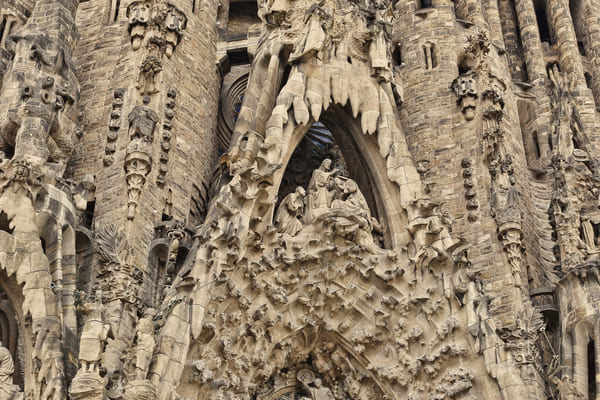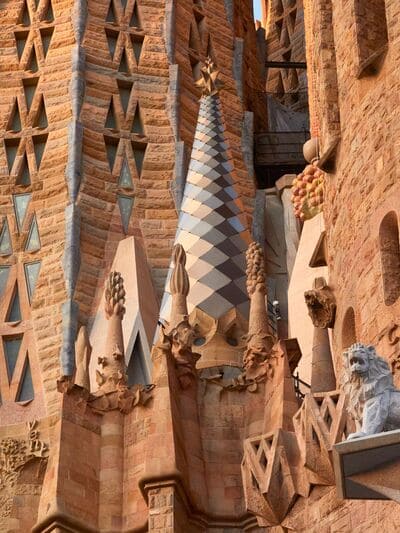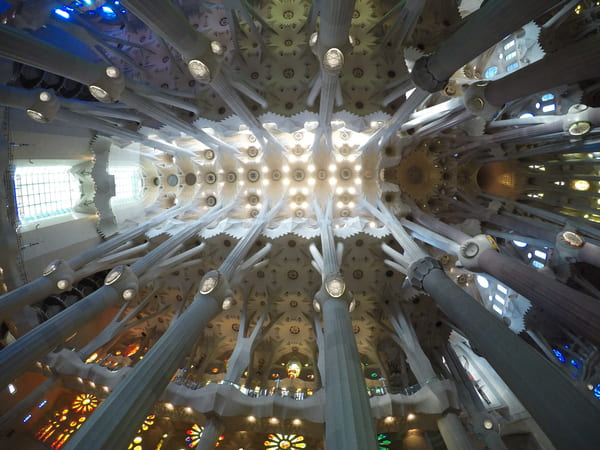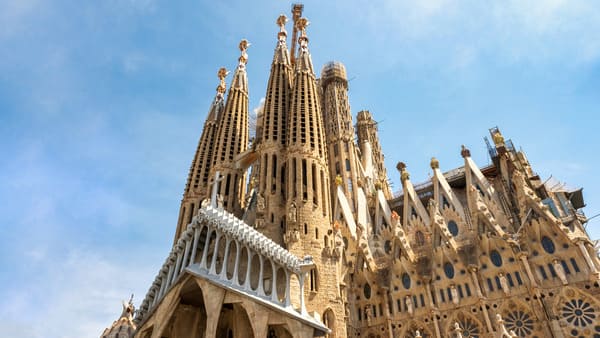The Sagrada Familia is not only the most visited monument in Barcelona, but also one of the most enigmatic of all Barcelona. Despite receiving millions of tourists every year, this temple keeps secrets that go unnoticed by most visitors, behind its imposing architecture hides a world of hidden symbols, religious meanings and details that Gaudí meticulously designed to convey his vision of the universe.
In this article, we invite you to look beyond the obvious and discover the mysteries that make the Sagrada Familia a unique work in the world.

Antoni Gaudí and Catalan modernism: trencadís, nature and symbolism
To understand the secrets of the Sagrada Familia, one must first understand the mind that designed it. Antoni Gaudí was the greatest exponent of Catalan modernism, an architectural style that broke with the classical to embrace creative freedom, inspiration from nature and the symbolic use of forms. In his works, and especially in the Sagrada Familia, everything has a hidden meaning: from the geometry of the columns to the use of color. One of his most recognizable hallmarks is the trencadísa mosaic made with ceramic fragments that turns the broken into beauty. This technique, far from being merely decorative, symbolizes the harmony born of chaos, and is present in domes, facade details and structural elements of the temple.
The façades of the Sagrada Familia and its hidden symbolism
The Sagrada Familia is not just a temple, it is a story carved in stone. Its three main facades – Birth, Passion and Glory – represent the most important moments in the life of Jesus Christ, and each was conceived with its own artistic style and symbolic language. Gaudí did not just design decorative sculptures, but an authentic visual catechesis that visitors can “read” if they know the clues. Below, we break down the hidden meaning of each one.

The Nativity façade
Located to the east, this façade was the only one directly supervised by Gaudí and represents the beginning of life. Naturalistic in style and deeply detailed, it is filled with plant and animal life: doves, leaves, angels, musicians, and of course, the scene of Jesus’ birth. Everything flows in harmony with nature, symbol of divine creation. The portals are dedicated to Faith, Hope and Charity, three essential Christian virtues.
The Passion façade
In stark contrast, this façade has a sober, almost aggressive style, with angular figures and hard lines. It represents the suffering and death of Christ. It was built after Gaudí’s death, but following his directions. The drama of the scenes, the lack of ornamentation and the rawness of the faces convey pain, sacrifice and redemption. This is where the famous magic cubealthough its symbolism is detailed below.
The façade of Glory
Still under construction, it will be the main and most monumental façade. It will represent the resurrection and glory of Christ, as well as the way to God through death, the final judgment and eternal life. Gaudí left numerous drawings and models to guide its execution. The enormous doors already installed display the Lord’s Prayer in dozens of languages, a symbol of the universality of the faith.
Mysteries of the Sagrada Familia that few know about
Beyond its imposing facades, the Sagrada Familia is a temple full of hidden messages.The design of the building, mathematical proportions and spiritual references that go unnoticed if they are not observed with attention. Gaudí left nothing to chance: everything has a reason. These are some of the most fascinating mysteries:
The magic cube and numerology
On the Passion façade is a numerical square in which all the rows, columns and diagonals add up to 33, the age of Christ at death. This magic cube not only demonstrates Gaudí’s mathematical precision, but his intention to encode spiritual messages in architecture.
Other numbers are repeated in different parts of the temple:
- 3 for the Trinity,
- 7 as a symbol of perfection,
- 12 by the apostles,
- 33 for the life of Jesus.
Sacred geometry in every corner
Gaudí used natural forms and advanced mathematics to design the temple: parabolas, hyperbolas, spirals and helixes. Nothing is straight or arbitrary. The columns branch out like trees, the staircases twist like seashells, and each form has a spiritual meaning linked to nature as God’s handiwork.

Light as a symbolic element
The illumination of the temple is not aesthetic, it is theological. The stained glass windows are designed so that the warm light of dawn bathes the Nativity side, while the cold light of dusk colors the Passion side. Thus, the visitor experiences a symbolic journey between the beginning and the end of life.
The sound you feel
The acoustics of the temple were designed to amplify not only music, but also spirituality. The conical shapes of the vaults and the arrangement of the columns generate a resonance that envelops the visitor. It is not just a matter of hearing, but of feeling the space as a sacred and vibrant place.

How to discover its secrets during your visit?
Visiting the Sagrada Familia is a unique experience, but if you want to discover its most hidden secrets, you need more than just a ticket and a camera. Here are some practical tips to make the most of your visit and see what many overlook:
Choose the right time and light of day.
If you want to see the play of light in all its splendor, the ideal is to visit the temple between 10:00 and 12:00, when the light from the east illuminates the central nave, or in the afternoon from 16:00, when the stained glass windows of the west stain the interior of cool tones. The light changes the perception of space and reveals details that only appear at certain times.
Use an audio guide or take a symbolic guided tour.
Standard guided tours are useful, but if your goal is to understand the symbolism and mysteries, look for a tour specializing in Gaudí’s symbolism or audio guides focused on curiosities and hidden details. Many explanations do not appear on the information panels.
Don’t run: watch patiently
Spend time on the small elements: the inscriptions, the animals, the geometric shapes. The Sagrada Familia is meant to be deciphered, not just admired. If something catches your eye, it probably has a hidden meaning.
Climb the towers… and look down…
If you have the option, climb one of the towers. Not only will you have spectacular views of Barcelona, but you will also be able to see from above structural details designed by Gaudí that cannot be seen from the ground, such as the helical shape of the stairs or the pinnacles decorated with mosaics.

Visit the interior museum
On the first floor you will find an exhibition with original models, drawings, historical photos and construction elements that explain how the project was developed. It is the ideal place to understand the evolution of the work and better grasp Gaudí’s vision.
A temple that still holds unanswered questions
The Sagrada Familia is much more than a monument: it is a living work, a temple in constant evolution that continues to hold unanswered questions. Despite the millions of visitors who visit it every year, its full message remains veiled. Gaudí did not seek to create a work that could be understood at first glance, but a sacred space that could be contemplated, felt and deciphered over time. Every form, every ray of light, every proportion is charged with symbolic intent. Its unfinished construction is not a defect, but part of its identity: an architecture open to the future, to new interpretations and to generations yet to come.
And it is precisely this inspiration – made up of beauty, faith, geometry and nature – that gives life to our collections at Barcino Designs. For more than 20 years, we have been paying tribute to Gaudí’s legacy with decorative figures designed in Barcelona and made with his most iconic technique: trencadís, the broken mosaic that transforms fragments into art.

